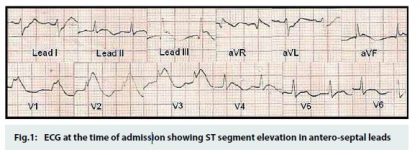- Home
- Editorial
- News
- Practice Guidelines
- Anesthesiology Guidelines
- Cancer Guidelines
- Cardiac Sciences Guidelines
- Critical Care Guidelines
- Dentistry Guidelines
- Dermatology Guidelines
- Diabetes and Endo Guidelines
- Diagnostics Guidelines
- ENT Guidelines
- Featured Practice Guidelines
- Gastroenterology Guidelines
- Geriatrics Guidelines
- Medicine Guidelines
- Nephrology Guidelines
- Neurosciences Guidelines
- Obs and Gynae Guidelines
- Ophthalmology Guidelines
- Orthopaedics Guidelines
- Paediatrics Guidelines
- Psychiatry Guidelines
- Pulmonology Guidelines
- Radiology Guidelines
- Surgery Guidelines
- Urology Guidelines
Aluminum Phosphide poisoning may present as Heart attack

According to a new case report, Aluminum Phosphide poisoning may present as a Heart attack.
Dr Majumder Biswajit at Department of Cardiology, R.G. Kar Medical College, Kolkata, West Bengal and colleagues have reported a unique and rare case where the patent had symptoms of Heart attack as heart was the predominantly affected organ due to aluminium phosphide(ALP) poisoning. It has appeared in the Journal of The Association of Physicians of India.
Cardiac involvement usually manifests with nonspecific ST-T changes in ECG. The case is unique because ECG and echocardiographic finding were mimicking with an ischaemic insult to a left anterior descending arterial territory and a Heart attack which is extremely unusual in ALP poisoning.
ALP poisoning (Celphos) has emerged as a common cause of accidental poisoning in children with mortality ranging from 37-100%. Since ALP is commonly used as a fungicide and rodenticide in India, many reports of accidental poisoning with severe consequences have been noted both in adults and children. The spectrum of symptoms and signs and their severity depends upon the time lag between ALP ingestion and hospitalization. The most common presentation is shocking with cold and clammy skin, a weak thready pulse and severe hypotension often refractory to vasopressors.
Read Also: Apollo performs liver transplant to save student who ingested rat poison
Case Report:
The case describes a 19 -year-old female patient presented to the hospital with a history of ingestion of 2 Celphos tablets with a suicidal intent (one tablet of Celphos - 3 gm). The time between consumption and hospital arrival was approximately 5 hours. At present, the patient complained of epigastric pain and nausea. She was conscious and oriented but restless with cold clammy extremities and diaphoresis. Her pulse rate was 110 beats/minute and blood pressure was 80/40 mmHg.
The oxygen saturation was 90% with pulse oximetry in room air. Routine blood examination and biochemical parameters were sent and the patient was started on rapid IV infusion with normal saline along with norepinephrine administered as per the standard dosage. Gastric lavage was performed and coconut oil was given through Ryle’s tube.
Electrocardiogram (ECG) recorded on arrival showed a broad QRS complex with ST elevation in mainly the anteroseptal leads mimicking anteroseptal wall myocardial infarction. Serum CPKMB was very high (290 U/L) and Troponin T was positive.
Echocardiography showed hypokinesia of IVS and anterior wall with a left ventricular ejection fraction of 30%. Over the next few hours, the patient’s blood pressure continued to fall despite being on norepinephrine and dopamine infusion was added but the patient continued to deteriorate. Electrolytes remained except for a mild decrease in serum magnesium and hence, IV Magnesium was given. But despite the best efforts of doctors the patient succumbed due to circulatory failure.

The patient referred in the case had severe myocardial depression with ECG changes resembling myocardial infarction/ myocarditis. ECG changes in Celphos poisoning have been studied in various studies. It includes atrial fibrillation, supraventricular and ventricular tachycardia, ST-T changes, bundle branch blocks, and AV conduction disturbances. Although ST-T depression with T-inversion is present in many cases but pure ST-segment elevation is not so commonly reported in the literature.
Read Also: Medication poisoning main cause of unnatural death in Epilepsy
"Cardiac involvement is marked by ST-T changes and bundle branch blocks in ECG and global hypokinesia with depressed left ventricular ejection fraction in echocardiography. However, ST elevation and regional wall motion abnormality as seen in our patient mimicking anteroseptal myocardial infarction is extremely rare", write the authors.
For reference log on to http://www.japi.org/october_2018/cs6.html

Disclaimer: This site is primarily intended for healthcare professionals. Any content/information on this website does not replace the advice of medical and/or health professionals and should not be construed as medical/diagnostic advice/endorsement or prescription. Use of this site is subject to our terms of use, privacy policy, advertisement policy. © 2020 Minerva Medical Treatment Pvt Ltd